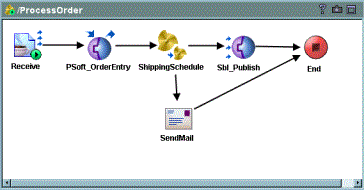Components of Process Definitions
A process definition is a graphical representation of your business process model. The figure: Example Process illustrates a simple process definition in the Design panel, which consists of a few activities, including two ActiveEnterprise Adapter activities.

A process definition consists of one or more of the following components:
| • | Activities |
Are the individual units of work in a process definition. Activities are generally operations that interface to external systems, as well as performing internal processing. Activities are available on the various palettes from TIBCO ActiveMatrix BusinessWorks.
| • | Transitions |
Describe the flow of processing in a process definition. A transition is represented by an arrow between two activities. The arrows are unidirectional, and you cannot draw a transition to a previously executed activity. Control flow in a process definition must proceed sequentially beginning with the Start activity (or a process starter) and ending with the End activity.
| • | Groups |
Specify related sets of activities.
| • | Shared Configuration Resources |
Are specifications that are shared among activities. These are resources, such as database connections, WSDL files, schema definitions, and connections to other servers. Shared configuration resources are created outside of process definitions, but you can use them when configuring some activities.
| • | Subprocesses |
Are child processes of a business process. Business processes are often very complex and it is difficult to diagram the complete process in one process definition. You can create several smaller process definitions known as subprocesses, instead of one large-scale process definition. You can then call each subprocess from another subprocess.